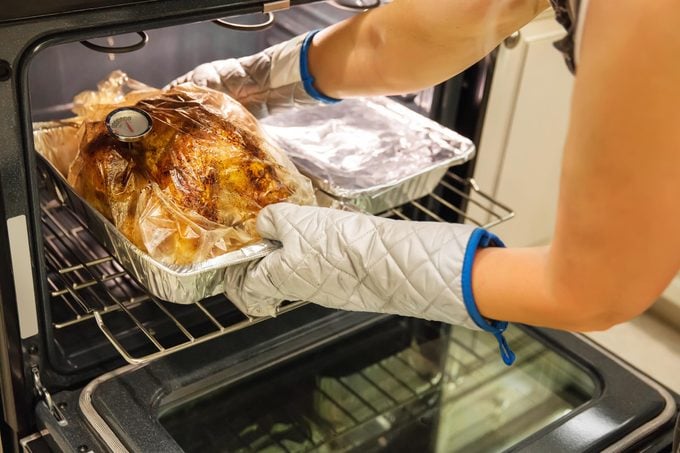The Pros and Cons of Cooking Turkey in a Bag
Updated: Dec. 02, 2023
Is cooking turkey in a bag the right move for Thanksgiving? Here are the pros and cons to consider.

If you’re cooking the annual Thanksgiving turkey, you might wonder if you should use an oven bag. It’s a method that many advocate makes a juicy turkey—and it’s foolproof for beginners. Find out all the pros and cons of cooking turkey in a bag before you decide if it’s the right choice for you.
Pros of Using Oven Bags
First, let’s talk about the benefits of using an oven bag when cooking your turkey. The top perk is: juiciness. No one wants a dry turkey, and the bag method helps you avoid that disaster. It traps in moisture to help the turkey stay juicy and tender as it cooks. Cooking in a bag also saves time, as your turkey will cook about an hour faster in the bag than what your recipe specifies.
A bag is also self-basting, which means condensation collects in the bag and drips onto the turkey as it cooks. You can basically forget about the bird once it’s in the oven, moving on to making Thanksgiving side dishes and all the other tasks that come with a busy day of cooking. Turkey in a bag makes for easier cleanup, too—no scrubbing a dirty roasting pan. Simply throw the bag in the trash after you’ve strained out the juices to make turkey gravy.
If popping plastic in the oven seems like a bad idea, don’t worry. Oven bags are made of materials that are heatproof past the average temperatures used in ovens. Most oven bags you’ll find in the store are FDA-approved (but always check) and don’t contain BPA or other dangerous chemicals.
Cons of Using Oven Bags
According to professional chef and cooking class instructor Malia Call, there are some drawbacks to the bag approach. “Many people swear by turkey in a bag, but I feel it’s an old-school method for cooking a turkey. It will be moist, but you sacrifice getting that nice crispy skin, which is arguably one of the best parts of the turkey,” she says.
Slathering your turkey in butter or oil before putting it in the bag will help with browning, but because of all that trapped moisture, you won’t achieve crispiness.
And while we’re on the topic of the downside of bags—never use a paper bag. During the 1950s, the idea of cooking a turkey in a paper grocery bag became trendy, and the notion still makes a comeback every few years. But according to the USDA, cooking your turkey in a paper bag is dangerous. There can be toxic fumes from the ink, glue and recycled materials in the bag. Plus, you can start a fire! So, never cook a turkey in a paper bag.
Should I Cook My Turkey in a Bag?
This method is fast and easy, so it might be the way to go if you’re cooking your first Thanksgiving meal. However, most chefs and home cooks don’t recommend it. Instead, opt for open roasting or spatchcocking and using a dry brine. Either method will give you a juicy bird and a crispy skin, the two things that will have your guests asking for seconds. The bottom line: “There are better ways to achieve the perfect turkey,” says Call.




















